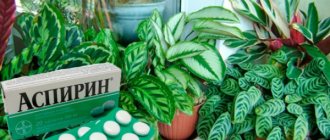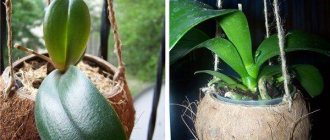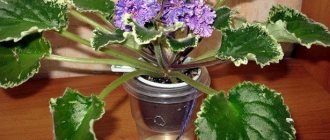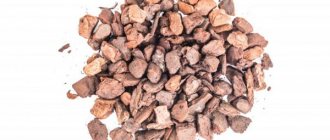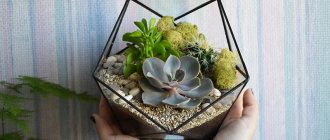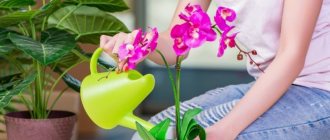How to plant at home?
Hibiscus is an unpretentious plant, but its transplantation has several subtleties.
Soil/soil - what soil is suitable for a tea rose?
Chinese rose cuttings are transplanted into loose soil with neutral acidity - it promotes their rapid root formation. Young plants need nutritious, but not greasy soil.
Adult hibiscus are less demanding on the soil; only 2 conditions must be met - drainage and good looseness . An adult plant is replanted only when the pot becomes too small for it.
Soil composition
To plant cuttings, use clean sand or a mixture of one part sand and one part peat. It stays in such soil for 25-30 days - during this period the plant develops a stable root system and it is already transplanted into a pot to form a bush. For a young tea rose, soil is prepared from the following components:
- 1 part compost or humus;
- 2 parts of turf;
- 1 part sand.
One part of the leafy soil is sometimes included in the composition to provide greater nutritional value.
To improve the looseness of the soil, pieces of charcoal and a little peat are added to it. And to speed up the formation of buds, add a small amount of bone meal to the soil. Clay shards or expanded clay are used as drainage.
What pot is needed when planting/transplanting??
In order for the plant to grow healthy and strong, the following recommendations must be followed:
- To plant Chinese rose cuttings, use a low pot (7-10 cm). Its diameter depends on the number of seedlings. After rooting, each cutting is planted in a separate container up to 10 cm high, with a radius of 4-5 cm.
- The size of the pot for an adult tea rose is chosen very carefully. When the crown of the plant grows extensively, the hibiscus is transplanted into a container one size larger: its diameter and height should be 5-7 cm larger than the size of the previous container.
- The materials used for pots should also be chosen carefully. Chinese rose grows well in ceramic pots and wooden tubs. In plastic containers, the plant's roots will overheat. Immediately after purchasing the pots, they are soaked in boiling water for 2-3 hours. Used containers are washed with running water (without the use of special cleaning agents).
The best season for planting and replanting hibiscus is spring . At this time of year, the plant gains strength and grows. The best period for propagating hibiscus by cuttings is from March to May : over the next two months of spring, the plant will take root and have time to gain color (read about the propagation of hibiscus in our material). Young, rooted cuttings that have formed shoots are planted in May. Transshipment of an adult tea rose can be done in any month of spring.
Do-it-yourself soil preparation
Still, in order to provide the plant with appropriate care and a long life, it is recommended to use soil prepared independently at home. This option is good because when you make your own soil, you can select the ingredients needed for a particular plant.
Knowing what elements the soil should be filled with to grow a particular plant, you can provide it with comfort and beauty for many years.
From the video you will learn how to make soil for Hibiscus:
For indoor plant
To grow hibiscus indoors, you can use a soil mixture you prepare yourself. It should contain humus, peat and sand in equal proportions, as well as turf, leaf and pine soil. Often an admixture consisting of charcoal and ash is added to the soil .
What kind of soil should I plant my garden in?
To grow outdoor types of hibiscus, peat, sand and humus are added to the ground. The soil should be nutritious and absorb water well.
Hibiscus plants also take manure well as fertilizer.
How to replant at home?
Transplanting a Chinese rose at home is a simple task, however, in order for the plant to quickly take root and begin to bloom, certain rules must be followed.
Replanting after purchase
It is not advisable to replant a tea rose after purchase, especially if the plant is in flowering state. However, if the hibiscus is sitting in an unsuitable pot, then it is best to transfer it to another container.
Is it possible to replant hibiscus in the fall - why?
The natural flowering period is winter and summer. Autumn is a dormant period, so replanting at this time of year is undesirable. However, the flowering time of the tea rose can be shifted. In order for the plant to form buds in the fall, pruning and replanting are done in May.
Hibiscus is transplanted only when it becomes really cramped in the pot. Young plants require this procedure once a year, adults (over five years old) once every 3-4 years.
What to do if it withers after transplantation?
Sometimes it happens that a tea rose withers and dries after transplantation. This is a normal reaction of a plant to a change of location and should not be ignored.
Causes
There are few reasons for hibiscus wilting, here are the most common ones:
- lack of light;
- change of place;
- excess or lack of moisture;
- damage to the rhizome during transplantation.
How to fight?
During the wilting period, the plant needs to be provided with access to light and moisture .
If the root system was damaged during transplantation, the Chinese rose will have to be re-transferred. To do this, the plant is carefully pulled out of the pot, the damaged roots are carefully cut off with a sterilized knife, and the sections are treated with potassium permanganate.
To speed up the healing process, vermiculite .
Following these simple recommendations will allow you to achieve abundant and regular flowering from your hibiscus.
See more photos of planting and caring for hibiscus below:
Diseases and pests
Based on the condition of the plant, you can determine what mistakes are made during care:
- Dark pink spots on leaves. Hibiscus needs little light and fertilizer.
- The leaves are drooping and drying up. Lack of water and too dry air.
- Abundant foliage but no flowering. Increased temperature during the dormant period, lack of lighting and overfeeding with nitrogen fertilizers.
- The lower leaves fall off and the new ones turn yellow. Watering with cold water or disease of the root system due to stagnation of water.
- The leaves turn yellow, but do not fly off. Excess calcium and chlorine, but deficiency of iron.
The plant is also often attacked by pests: aphids, thrips, whiteflies and spider mites. When infected with them, the leaves curl, turn yellow, buds do not develop, and sticky coatings appear. To get rid of pests, wipe the leaves with a cotton swab dipped in a soap solution. In case of severe infection, insecticidal preparations “Fitoverm”, “Inta-vir”, “Aktellik” are used.
Hibiscus is an unpretentious and picky plant . If you provide it with bright lighting, timely watering, timely pruning and feeding, and also arrange a dormant period every winter, then it will delight you with beautiful flowering and its decorative appearance.
Replanting hibiscus. Photo
Why isn't your hibiscus blooming? The most likely reason is that the pot is too tight. Hibiscus grows quickly. Before you know it, the recently rooted cutting has turned into a bush and needs replanting. In a cramped container, hibiscus does not have enough nutrients; it very quickly consumes the moisture contained in the pot. As a result, hibiscus growth slows down, not only its buds, but often its leaves fall off. To prevent this from happening, hibiscus must be replanted in a timely manner.
When is the best time to replant indoor hibiscus?
Young hibiscus plants are replanted every year, and sometimes 2 times a year, each time increasing the size of the replanting pot by 4-5 cm in diameter. Plants older than 5 years are replanted every 3-4 years, but the top layer of soil is replaced every year. Fast-growing young hibiscus plants can be replanted in spring, late summer and fall. It is better to replant adult specimens in the spring: they grow more slowly and rarely need urgent replanting, so you can choose the optimal time for it.
The new pot should not be too big. It is enough to choose dishes 4-5 centimeters larger in diameter than the previous one.
Land for planting hibiscus
The soil mixture for replanting should be loose, nutritious and neutral. The most suitable composition: 2 parts each of leaf, turf soil and humus and 1 part sand. It wouldn't hurt to add a small amount of charcoal and ash. The following mixture is also suitable: 2 parts peat, 1 part humus, 1 part garden soil and 0.5 parts washed sand.
Hibiscus prefers neutral soils, and peat is usually highly acidic. Therefore, add 0.5 cups of wood ash for every 2 liters of earthen mixture, as well as 1 tbsp. l. complete mineral fertilizer.
If you prefer to use ready-made nutrient soils from the store, then choose soil mixtures with a neutral reaction for replanting hibiscus. Place a 3-4 cm layer of drainage at the bottom of the pot. This will protect the soil in the pot from souring.
Carefully remove the hibiscus from the old pot. Carefully, being careful not to damage the roots, remove the old drainage.
Planting hibiscus
Carefully inspect the earthen lump. If the soil is not acidic and there are no pests in it, then the hibiscus can simply be transferred, that is, transplanted into a larger pot without destroying the clod of earth. Hibiscus roots should be light and elastic - then they are in good condition. When some of the roots become dark, brown, and crusty soft areas appear, this indicates that they have rotted.
How often should indoor hibiscus be replanted?
The Chinese rose is replanted every spring in the first three years of the growing season. During this time, the plant manages to grow to the size of a small bush or tree. The shape of the crown depends on the specifics of pruning. Next, the hibiscus is replanted at intervals of two to three years. Transplanting an adult plant presents some difficulties, since it is a long-lived, tall species. Typically, five to six year old hibiscus is grown as a tub crop.
Indoor hibiscus grown in a tub is not replanted, but the top layer of soil is replaced.
They do this as follows:
- The substrate is watered abundantly one or two days before the planned event.
- The top layer is carefully loosened with a wooden stick and removed with a spatula.
- They try to carefully remove the maximum amount of undeveloped substrate.
- In its place, fresh soil is poured, which is compacted manually.
The optimal distance from the ground to the top level of the tub or pot is one to two centimeters. In this case, the plant will receive a sufficient amount of moisture in one watering. The water will not flow over the edge of the pot, but will be absorbed by the substrate.
All about caring for Chinese hibiscus
Buying plants . Quite strong and interesting varieties of “Dutch hibiscus” can be bought in our flower shops when the sales season in Holland begins, from early April to September. In winter, insufficiently resistant specimens are supplied. “Florida” varieties can only be purchased from amateur flower growers.
Priming. Hibiscus needs moisture- and breathable soil. Ready-made, purchased peat-based soils are not entirely suitable for successfully growing hibiscus. It is good to add leaf humus to these substrates; it structures the soil and makes it moisture-absorbing. Adding sand and turf soil will have a good effect. The soil should be slightly acidic, pH 6.8. At other pH values, hibiscus will not be able to absorb the necessary nutritional components from the substrate.
Illumination, temperature. Hibiscus prefers windows with a southern orientation; it is able to grow on those window sills where many other flowers simply burn out. This could be a southeast, south, southwest window. It will not be possible to achieve sustainable long-term flowering on north-facing windows, since hibiscus needs to be in direct sun for 4-6 hours a day to bloom. This plant came to us from the tropics, so it does not have a dormant period due to nature and is ready to bloom as long as there is enough light and the temperature is suitable, even all year round. Comfortable temperatures for Hibiscus Rosa-sinensis range from +24 to +30 degrees. At higher temperatures, buds may fall off. On particularly hot days, you need to shade the hibiscus a little from the direct sun.
It is also necessary to protect the hibiscus roots from overheating, especially if it is planted in a dark plastic pot. The temperature at which hibiscus stops blooming is +15 degrees; at temperatures below +10 degrees, the roots stop absorbing water, as a result, even with a moist clod of earth, hibiscus leaves droop. The critical temperature is +7 degrees.
Some varieties of Chinese hibiscus, especially those with brown flowers, need slightly less light.
Watering. During its active growing season, which lasts as long as there is light and warmth, hibiscus requires a lot of moisture and loves abundant watering, especially on hot days. This plant is not adapted to storing water in its parts, so a lack of moisture immediately causes a decrease in turgor; the hibiscus can lose all its leaves. If drying is prolonged, the plant will die.
However, the plant should not be allowed to overflow; with stagnant moisture, the hibiscus roots are affected by fungal diseases and rot; in addition, oxygen ceases to flow to the roots, which is very important for the plant. It is necessary to water abundantly, but do not allow the presence of water in the pan - hibiscus does not like “wet feet”. It is recommended to water your hibiscus early in the morning so that the plant dries out during the day. On winter days, when there is little light and it becomes cool on the windowsill, the hibiscus falls into forced sleep. The need for water decreases, it is necessary to reduce watering so that the roots do not rot. If for some reason the hibiscus has lost all or many of its leaves, then its transpiration is greatly reduced, watering must also be reduced, and the soil ball must be kept slightly moist.
Feeding. Hibiscus at the stage of intensive growth needs regular fertilizing with complex fertilizers. However, fertilizers for flowering plants are not suitable for it. It has been noted that G. chinensis needs much smaller doses of phosphorus than other flowering plants; excess phosphorus negatively affects the quality of flowering, its abundance and causes poisoning of the plant. In this case, the potassium content should be high. Optimal formula: NPK=9-3-13; 10-4-12; 12-4-18 (nitrogen, phosphorus, potassium). Therefore, standard fertilizer for flowering plants with the formula NPK = 16-20-27 from POKON, NPK = 15-21-25 from Agricola, NPK = 3.8-7.6-7.5 from Etisso and others are not suitable for hibiscus . In terms of composition, the closest to the optimal formula was the universal fertilizer for potted plants from POKON with NPK = 7-3-7.
In addition to the basic nutrients, hibiscus needs magnesium; it is the core of the chlorophyll molecule. With a lack of magnesium, chlorosis occurs, and the leaf turns yellow between the veins, which remain green, and sometimes dark spots appear on the leaves. To compensate for magnesium deficiency, you can use Epsom salts, but it is better to purchase magnesium in chelated form (Siliplant), you can use Greenwold fertilizer for conifers containing N - 3%, K - 2%, MgO - 5%, this will also serve as an additional source of N and K.
Feeding should be done on cool days, early in the morning or in the evening after sunset, and only over a previously spilled clod of soil. You can feed once a week, but it is better to apply fertilizer more often, but in proportionally reduced doses.
Hibiscus responds well to foliar feeding. For them, you need to dilute the fertilizer 10 times the weekly dose to feed the roots and sprinkle the leaves in the morning or evening. With a decrease in the rate of vegetation, along with watering, the dose of fertilizers should also be reduced, and if there is complete rest, fertilizing should be stopped altogether. You cannot feed a recently transplanted plant.
Frequency of watering and fertilizing
Hibiscus loves moisture very much, and therefore it is necessary to provide it with regular watering and spraying. The most optimal frequency of watering is twice a day. However, during flowering the plant needs more moisture, otherwise the flowering process will be slower. Therefore, during the growing season, it is necessary to water hibiscus as often as possible.
The plant needs regular feeding.
The frequency of feeding depends on the condition of the plant, usually it is done at intervals of up to once a month. In spring and summer, gardeners feed the flower more often: once every 10-15 days. Fertilizers for hibiscus must necessarily contain the following list of elements:
During flowering, fertilizers with a high nitrogen content are usually used.
The process of growing hibiscus requires compliance with certain rules. Providing your plant with quality soil is the first step to ensuring it stays healthy and continues to bloom for as long as possible. Since hibiscus is not picky about soil conditions, the main thing here is to provide the soil with moisture and drainage.
Source
Hibiscus
Hibiscus
is a plant of the Malvaceae family (Malvaceae). According to various sources, it includes 150-300 different species. These plants can be either cultivated or wild.
Hibiscus are evergreen or deciduous plants. They can be in the form of herbaceous plants, shrubs or trees. The flowers are usually quite large, with brightly colored corollas.
The color range of hibiscus consists of thousands of different colors and shades. Flowers have a wide variety of sizes from 5 to 30 centimeters. The hibiscus fruit looks like a capsule. A hibiscus bush can live for more than 20 years. Hibiscus can grow up to 3 meters with proper maintenance and favorable conditions.
Hibiscus grows in the subtropics and tropics (Indonesia, Southern China, the islands of Haiti, Fiji, Sumatra, Java, Sri Lanka).
Many species of hibiscus are grown in gardens and greenhouses as ornamental plants; they form beautiful hedges.
The most common species is the Chinese rose (Hibiscus rosa-sinensis). The plant has large double red flowers.
Types and varieties of Hibiscus for growing at home
General information about the plant:
- in nature, the height of some tree species reaches 10 m or more;
- genus from the Malvaceae family;
- there are shrubs, trees and herbaceous plants, annuals and perennials;
- in nature, Hibiscus grows in the tropics and subtropics, in Europe and America;
- large leaves, large flowers, lush crown, bright greenery, shades of petals - from white to deep red;
- A popular greenhouse and indoor plant is the Chinese rose. The photos help to understand why, when looking for an ornamental plant to decorate offices, Hibiscus rosa-sinensis is chosen with large, bright red, scarlet-tinged flowers, simple or double;
- a tree with a central trunk grows up to 2–3 m, sometimes higher, requires pruning and crown formation;
- the homeland of indoor hibiscus (Hibiscus rosa-sinensis) is the Malay Archipelago;
- Breeders have developed many interesting varieties of Chinese roses with varied shades of petals.
There are many types of Hibiscus in nature:
- Hibiscus Syrian tree.
- Trifoliate.
- Volatile.
- Chinese.
- Bolotny.
- Sudanese.
- Cosmatofruitous.
- Trifoliate.
- Terry.
Some species change the shade of their petals during different flowering periods. Previously, the Chinese rose had only bright red petals, but in recent years hybrid varieties with different bud colors have been developed: white, yellow, combined, with a bright center.
Landing
Hibiscus should be planted at the end of winter. The seeds must be pre-soaked for 12 hours. It needs to be planted in a mixture of sand and peat. It is necessary to create conditions like in a greenhouse, constantly spraying and ventilating.
Location and lighting
Hibiscus is a light-loving plant. It needs a warm and sunny location in which it begins to bloom in March. Hibiscus can grow in the shade, but lack of light has a negative effect on growth and flowering. In the summer, the plant will greatly benefit from being in the fresh air. In winter, keep at a temperature of 15°C. Compliance with these conditions will affect the increase in the number of buds.
Pot size
The size of the hibiscus pot should match the size of the roots. Also important is the presence of drainage in the flower pot.
The soil
A ready-made soil substrate for ornamental shrubs is best suited. It is loose, waterproof and contains a large number of nutrients. If you prepare the soil yourself, the composition should be as follows: turf soil, leaf soil, pine soil, humus (one part at a time), and you should also add peat and sand. Adding charcoal won't hurt either. The acidity should be closer to neutral.
Transfer
To replant, you need to take expanded clay and pour it onto the bottom of the pot. Pour some soil into the pot. Place the hibiscus together with a lump of soil in a pot. Add more soil until the pot is full. To ensure that the hibiscus grows straight, it can be tied to a support. Afterwards, you need to water the soil well and cover the pot with film for two days near the roots. This will allow the hibiscus to more easily adapt after the stress suffered during transplantation. Next, the film is removed and the flower grows in the usual way. The main thing now is to provide good lighting, constant watering and fresh air.
It is not worth fertilizing plants that have just been transplanted right away. It is best to do this after two weeks. It is necessary to carefully monitor the looseness of the soil.
Fertilizers and fertilizing
Hibiscus need regular fertilization and love it very much. In order for the flowering to be beautiful and bright, and also for the plant to grow successfully, fertilizing them is simply necessary. It is important to know that this plant does not tolerate phosphorus and loves potassium. In spring and summer, fertilize up to twice a week. In autumn and winter, fertilize once a week.
Watering
Hibiscus really needs proper watering. In summer, abundant watering is required; in winter, water less, but make sure that the soil does not dry out. In spring and summer, hibiscus needs spraying every two days. If the weather is hot, then you need to spray every day. In winter, spraying is required only if the air humidity becomes lower due to radiators. Water for irrigation and spraying must be settled.
Frequent spraying protects the plant from pests such as scale insects, aphids, and spider mites.
Temperature
Hibiscus is an unpretentious plant, but does not like sudden temperature fluctuations and drafts. The temperature should be 20-25°C. In winter, hibiscus needs a cooler temperature - 12-18°C. But the temperature should not fall below 10°C.
Humidity
Hibiscus can tolerate dry air without problems. Does not require additional moisturizing. But sometimes the crown can be rinsed with warm water in the shower. This is done to clean the leaves of the plant from dust and dirt.
Trimming
It can easily withstand severe pruning. It is best carried out at the beginning of the spring - late autumn. The main thing is to do this before the formation of flower buds, otherwise flowering may occur later than expected. It is necessary to remove dried shoots and cut healthy ones in half.
Care instructions
In order for a young plant obtained from a cutting to fully develop and grow, it is important to create comfortable living conditions for it. This requires compliance with the following requirements:
- sufficient illumination;
- optimal temperature conditions;
- sufficient air humidity;
- timely watering;
- feeding;
- prevention of pests and diseases.
Lighting
After rooting, the young hibiscus is placed in a well-lit place (on a windowsill, heated balcony), while avoiding direct sunlight on its leaves. Moderate diffused light is considered the most comfortable for these delicate exotics.
Temperature
Tropical origin causes increased temperature requirements for hibiscus. These exotics feel best at a stable air temperature of about 21° in summer and 15° in winter. Temperature changes, cold snaps and drafts are detrimental to these plants, as they cause a sharp decrease in their immunity and, as a result, the development of diseases.
Sufficient air humidity
The tropics and subtropics are areas where high humidity constantly reigns. It is necessary for rooting cuttings, young and adult plants. To make hibiscus feel comfortable, it requires regular spraying.
When carrying out this procedure, it is important to ensure that water does not get on the developing buds and flowers. Household humidifiers, as well as wide containers of water installed next to the pots, will ensure constant air humidity.
Timely watering
As a typical representative of the tropics, hibiscus does not tolerate drought. It must be watered regularly, making sure that the soil mixture in the pot does not dry out. However, an excess of moisture in the substrate should not be allowed, otherwise this may cause root rot.
Feeding
Young plants that have entered the phase of active growth and development require a lot of resources. To give them additional strength, fertilizing is used.
Prevention of pests and diseases
It is very important to protect young plants grown from cuttings from diseases and pests. For preventative purposes, young hibiscus are regularly inspected, and recently acquired plants are temporarily isolated from the rest.
Both the store-bought substrate and the components of the soil mixture for DIY preparation must be tested.
Transplantation and propagation of Hibiscus (Chinese rose).
Hibiscus or Chinese rose is a beautiful flowering plant. You are waiting for it to bloom, but the hibiscus still does not bloom . Most likely the reason is that the leaky potty has become too tight for your pet. A young plant requires replanting at least once a year. As it grows and ages, the Chinese rose can be replanted no more than once every 2-3 years. So how do you get hibiscus to bloom? It’s very simple to transplant it into a larger pot. How to do this, read our article.
Why do you need to replant an indoor flower?
Indoor hibiscus is well known to lovers of home flowers. It is also called Chinese rose. It is difficult to say why the plant is associated with the Celestial Empire, despite its large growing area, hibiscus in China is still a rarity. For home cultivation, many varieties bred by breeders are used. The external difference between the subspecies is the different shade of flowers. There is also a variety of Chinese rose with pockmarked, white-green leaves. Whatever flower you choose, it will be useful to know how to create optimal living conditions for it. The Chinese rose is unpretentious and in order for it to grow and regularly delight you with flowers, you will not need much.
Young specimens need replanting every year. As it grows, it will be enough to change the planting container and soil every 2-3 years.
Before you run to the store for a new pot or soil, make sure that the replanting procedure is necessary for your hibiscus.
Usually, the main sign that allows you to think about an urgent transplant is the root system of the plant that has become stronger and has grown throughout the earthen coma.
Replanting is also necessary for those plants that you recently purchased at a flower shop. In these cases, most often poor-quality or poor soil mixture is used to transport and maintain flowers. So experienced gardeners advise replacing the soil with a better quality one and the pot with a more suitable one as soon as possible (but this should be done only after the hibiscus has recovered a little from the stressful move).
An equally significant reason for replanting a flower may be the presence of stimulants in the soil. Manufacturers often add substances to the soil mixture that promote active flowering of the plant. Because of this, its growth slows down sharply and the risk of spider mite infection increases significantly.
Replanting hibiscus.
Transplanting hibiscus is a very simple process and will not take you much time and effort. First you need to carefully remove the plant from the pot and check whether the problem is really in a cramped pot. This is very simple to understand - if the root system has filled the entire pot, then it is necessary to transplant it into a more spacious one . It will look like the photo below:
The hibiscus root system has taken over the entire pot.
However, when replanting, you should choose a pot that is not much larger - just a couple of centimeters, otherwise the hibiscus, on the contrary, may refuse to bloom, since only the roots of the plant will grow.
The most common question when replanting hibiscus is whether to knock down the old soil from the roots? If, when examining the roots, you do not find any damaged parts, then it is not necessary to shake off the old soil from the roots; you just need to add new soil to a larger pot. If you find rotten roots, they need to be trimmed to healthy tissue and the old soil knocked off the roots.
This is what the prepared soil for planting hibiscus looks like.
Using drainage is mandatory if you want to prevent the roots of your plant from rotting. Soil for hibiscus can be bought ready-made for flowering indoor plants, or you can prepare it yourself using garden soil, sand and peat in a ratio of 2:1:1, respectively. In addition, you can add ceoflora to the soil; it will not allow the soil to compact and the roots of the plant will breathe.
An example of ready-made soil for hibiscus
In order for the hibiscus to feel comfortable in the future, it needs to be properly cared for.
Preparation for wintering is an important stage
Garden tree hibiscus sheds its leaves for the winter. In the middle zone it grows no higher than two meters. Hibiscus blooms from July until the first frost. Frost-resistant varieties are considered to be those that do not freeze in mild southern winters. In the middle zone, tropical plants need shelter. For cultivation here, varieties with simple, non-double flowers should be used.
In winter, the plant is watered abundantly, after the top layer has dried, it is hilled high, but sand is added to the ground by a third. When stable frosty weather sets in, the plant is covered with shavings, sawdust, dry leaves - loose bedding about 15 cm high.
The branches are bent to the ground as far as possible and covered with dense non-woven material in several rows. A frame is built on top, onto which insulating materials and coniferous spruce branches are subsequently thrown. The photo shows how garden hibiscus overwinters in the garden.
In temperate latitudes, tree hibiscus can overwinter only with insulated roots, but it is necessary to prepare a frame for survival in extreme conditions. In areas with a continental climate, garden hibiscus is guaranteed to be preserved in cellars by digging up a plant with a large lump of earth.
Herbaceous hibiscus will overwinter if it is insulated after the above-ground part dies.
Hibiscus propagation.
Reproduction of hibiscus is possible in two ways - seeds and cuttings . If you are the owner of an already mature plant, you should be aware of the need for annual pruning. We have already written about how to properly prune hibiscus. Cuttings obtained by pruning can be used to propagate Chinese roses. Propagation by cuttings has a great advantage over propagation of hibiscus by seeds - in the first case, the plant can be finished flowering already in the first year, while when planted from seeds, hibiscus blooms only for 2-3 years.
Why hibiscus is called the flower of death: signs and superstitions
The hibiscus rose is often called the flower of death. There is no exact information regarding the history of this name, but various superstitions and signs associated with the plant have long existed. According to ancient beliefs, you can bring death into your home with a Chinese rose. In fairness, it is worth clarifying that such superstition haunts not only hibiscus - the deadly stigma also affected azalea, calla lily and ivy.
As for the Chinese rose, there are several signs associated with the plant:
- If a flower unexpectedly sheds its leaves, then there is a high probability of imminent troubles and serious illnesses. It is believed that this is how the plant warns household members about health problems.
- Untimely flowering of indoor hibiscus promises the imminent death of one of the family members. In ancient times, such a plant was immediately burned so that the omen would not work.
- It is believed that the Chinese rose negatively affects the health of the owner, so it should not be placed in the bedroom.
- There is also an unconfirmed sign that hibiscus destroys family happiness and “drives” men out of the house.
Perhaps for one of the flower growers, the shedding of leaves or the flowering of a plant coincided with bad events in life, which became the reason for such bad fame. But today the Chinese rose is an incredibly popular plant that has nothing to do with sinister superstitions.
Many people like the flower, but because of the signs they doubt whether it is possible to keep hibiscus at home. The plant is not poisonous, therefore it is not dangerous for indoor keeping, and there is no serious reason to believe superstitions.
Reproduction of hibiscus by cuttings.
Cuttings for propagation must be taken freshly cut. These cuttings can be either placed in water or planted in the ground.
If you are more familiar with the first option, then prepare the dishes in advance and pour settled soft water into it. It is usually advised to use dark glass containers, but we have seen from our own experience that a regular plastic bottle will do. Place the cutting (or cuttings) in water and wait for the roots to appear . As a rule, rooting occurs in 25-30 days.
The second way is to plant the cuttings in wet sand with peat in a 1:1 ratio. Rooting time is the same as in the first case - about a month.
Rooted hibiscus cuttings.
After a month, rooted plants for indoor flowering plants, according to the tips above.
How to properly replant indoor hibiscus
Experienced flower growers rarely rely on luck, preferring practical experience and knowledge to it. Knowing how to properly transplant hibiscus at home, you can get a healthy, blooming specimen for many years. Hibiscus belongs to a small group of long-lived indoor plants and in a short period of time they become pot crops.
Reproduction of hibiscus by seeds.
The most favorable time for planting seeds is the end of winter - the beginning of spring. The seeds must be soaked for 12 hours in a special growth-stimulating solution. Epin or Zircon for this . Next, wash the seeds with a weak solution of potassium permanganate (this is not a necessary condition!).
Place the swollen hibiscus seeds in a piece of damp cloth, covering them with cellophane. Maintaining a high temperature - about 25-27 degrees, do not forget to periodically moisten the seeds and ventilate them so that they do not become moldy.
When you see that the seeds have begun to germinate (as in the photo above), they will need to be planted in the ground.
If you did everything correctly, then soon seedlings will appear from the planted seeds, which can be planted in separate pots as soon as they produce 2-3 leaves. Hibiscus seedlings.
How to care for shrubs in open ground?
Garden hibiscus are grown in open ground, but indoor varieties are less frost-resistant and do not take root. Therefore, they are only taken out into the garden in the summer, shaded from the sun, and protected from drafts and rain.
At the same time, garden hibiscus are undemanding to the soil , the main thing is that it is fertile and loose. They love moisture, but are drought-resistant. And for successful cultivation, a place well lit by sunlight is ideal for them. But at the end of summer, hibiscus is mulched with fallen leaves or grass. And for the winter they are covered with a frame or special material.
Hibiscus turns yellow and does not bloom: what to do in this case?
When looking for an answer to the question of why hibiscus leaves turn yellow, you should look for errors in care:
- Watering with hard, chlorinated water is a common cause of yellow leaves. A similar problem can arise when moisturizing with cold liquid. Watering only with soft water that has settled for several days will help correct the situation.
- Why does hibiscus turn yellow and fall off? A possible reason is waterlogging of the soil. Watering should be stopped to allow the soil to dry, and the pot should be moved to a ventilated place.
- The plant may respond to too high a temperature and poor moisture by turning yellow and dropping leaves. Thus, it reduces the need for water consumption.
- Sometimes hibiscus leaves change color due to drafts. You need to move the pot to a warm place and properly organize the ventilation of the room, moving the plants to a safer place.
- A substrate that is too acidic or alkaline causes the leaf blades to turn bright yellow. Alkalinization is promoted by using too hard water for irrigation. Acidity is changed by applying chelated fertilizer.
Yellowing of foliage
Sometimes indoor hibiscus does not bloom, no matter how hard the gardener tries. The cause may be either improper care or plant disease. What to do if the buds don't appear? There are several options:
- Reduce the room temperature in winter to allow the plant to rest.
- The nitrogen content in the soil is exceeded. In order for the bush to bloom, the proportion of this element in fertilizers is reduced, preference is given to potassium-phosphorus additives. The same is done if the buds fall off.
- There is not enough light for hibiscus to form buds. Moving it to a lighted place will help correct the situation.
- Pests weaken the entire plant. If parasitic insects are found - thrips, scale insects, nematodes, spider mites, the plant is treated with an insecticide and transplanted into new soil.
- Dropping of buds is caused by nematodes and thrips, poor drainage, excessive moisture and fertilizing.
The Chinese rose, whose photo leaves few people indifferent, is a welcome guest in many homes. The flower is famous not only for its beauty, but also for its healing power. A little effort and in a few months a blooming hibiscus appears on the windowsill to the delight of the housewife.
Common mistakes when growing
How to grow hibiscus so that it always has an attractive appearance? Unfortunately, no one is safe from diseases and pests. But most often, the poor health of a flower is associated with errors during cultivation. Here are the most common problems encountered when breeding Chinese roses:
- Does not bloom or blooms poorly. Most often this happens due to lack of light, improper watering or too large a pot. You also need to take into account that hibiscus gains color well when the temperature drops.
- The leaves are turning yellow. This occurs due to pest damage, the use of cold water for irrigation and a lack of minerals.
- If the leaves of a plant turn yellow and the roots dry out, then this is either an infectious disease (chlorosis) or changes caused by improper watering.
Hibiscus is an amazingly beautiful plant. And if you care for it with love, it will bloom long and abundantly.
Beneficial features
One of the beneficial properties of hibiscus is the ability to accumulate and absorb ultraviolet radiation, therefore its components are used in the manufacture of creams that protect against ultraviolet radiation.
Dried hibiscus sabdarifa leaves are added to the popular hibiscus tea. This reddish-ruby colored tea drink is high in vitamins C and PP, antioxidants and organic acids.
Red tea is useful for strengthening the walls of blood vessels and general blood circulation, it strengthens the immune system and restores blood pressure, and also reduces cholesterol levels. Tea can be served both hot and cold, complementing the taste with various spices and herbs. Hibiscus came to Russia from hot southern countries and was used for a long time as an antipyretic drink.
In countries located on the shores and islands of the Pacific Ocean, the Chinese rose is also common. The leaves of this plant are added to national dishes and salads.
Malaysian travelers bring banknotes and coins with hibiscus images as souvenirs. In the 70s of the 20th century, the Chinese rose was recognized as the flower of the nation of this country. Hibiscus is no less popular in Haiti. The flower is used in massage rituals and dishes. In India, wedding ceremonies are decorated with inflorescences.
Plants from the hibiscus family are directly related to Malvaceae. In natural areas they can be seen in Asian countries, in the European south of our continent, in Africa, America and even on the islands of Oceania. They are evergreen trees reaching a height of 2-3 meters. Some species are herbaceous or deciduous plants.
At home, the most striking representative is the Chinese rose. Photos and illustrations demonstrate the bright silhouette and grace of the flower. In countries with warm climates, where night temperatures do not fall below 18 degrees, hibiscus is grown in open ground.
In the temperate and subarctic zones, it is common in decorative floriculture in various subspecies: Chinese, Syrian, sabdarifa or otherwise Sudanese rose.
Indoor hibiscus is distinguished by tops of a rich green or dark color, diluted with splashes or veins of other colors.

